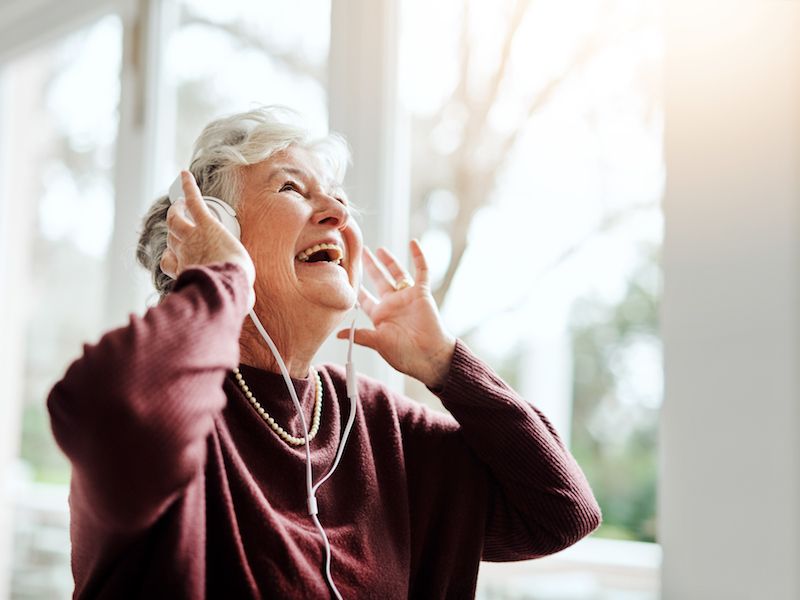
People who work in loud environments like construction sites or at heavy metal concerts are not the only ones impacted by noise related hearing loss. It doesn’t even have to be work-related, recreation-related noise exposure can be dangerous, also. What type of exposure are we dealing with? Music, gaming, streaming video or anything that you would listen to through headphones or earbuds.
You may not believe your smartphone or tablet can get that loud. But these devices can achieve continuous volumes of over 105 dB, which is around the normal human pain threshold. Your ears will literally start to feel pain at this volume. So what can you do to safeguard against this type of noise-related hearing loss?
It’s relevant here to think about the volume. Listen with the volume at or below 60% for 60 minutes or less each session (how long you listen for also matters), this is called the 60/60 rule.
Create a Setting on Your Hearing Aids For Music
If you wear hearing aids, you’re most likely streaming your mobile device right to your hearing aids, so be certain the volume is not too high or that you’re not attempting to drown out other sounds with your music. And there are much healthier ways to listen to music so consult us about that also. If you’re a musician or real music aficionado you might have recognized that most hearing aids are developed to sharpen the quality of voices…not necessarily music. We may be able to change the configuration to decrease noise and feedback while increasing some frequency to enhance the quality of sound while listening to music.
What Are The Best Headphones For You?
When buying headphones there are many choices, especially if you have hearing aids. It might be a matter of personal preference, but there are some things you will want to consider there too.
Headphones That go Over The Ears
Over the ear headphones are becoming popular again but you most likely won’t find the old foam covered ear pieces that once came with a walkman. Often unexpectedly costly, they offer a large variety of color possibilities and celebrity endorsements, and of course, superior sound quality. And unlike those little foam pads, these go over the whole ear, stopping outside sounds.
Conventional wisdom is that these are less dangerous than in-ear headphones because the source of the sound is further from your eardrum. But the reality is they’re often able to reach louder volume than the smaller kind, the speakers are a lot larger. Noise cancellation can be a good thing as long as you’re not missing out on important sounds like an oncoming automobile. But on the upside, you don’t need to compete with outside noise so you can listen to your music at lower volumes.
Earbuds
The normal earbuds that are included with devices such as iPhones are much maligned for their inferior sound quality, but because they come along with your phone a lot of people still use them. In addition, with newer versions that no longer have a headphone jack, staying with Apple’s earbuds can simply be easier.
Earbuds also don’t cancel out sound so the downside is, you tend to crank up the volume. Once again,, though it’s commonly said that earbuds are a problem because you stick them into your ear so their speakers are very close to your eardrum, actually volume is really the biggest concern.
Noise Blocking Earbuds
Many people opt for earbuds with a rounded, rubbery tip both because they’re more comfortable than traditional earbuds and better at stopping outside sounds. The rubber molds to the shape of your ear, producing a seal that stops other noises from entering. But these earbuds can also block out noises you might need to hear and loud volume is still the number one issue. Needless to say, these won’t work for you if you use hearing aids.
A number of pairs will probably have to be tested before you find headphones that are correct for you. Depending on what you’re most often using them for say talking on the phone, as opposed to listening to music, you’ll have unique acoustic expectations. The relevant thing is to seek out headphones that make it comfortable for you to listen at a safe and secure sound level.
Don’t Cut Corners When it Comes to Your Hearing
How can you be certain it’s safe? There’s an app for that…If you have a smartphone, you can get the National Institute for Occupational Safety and Health’s free Sound Level Meter app. There are different apps you can get, but research has found that the reliability of these other apps is hit-and-miss (additionally, for reasons yet unknown, Android-based apps have been shown to be less accurate). That motivated NIOSH to create an app of their own. You can measure external noise with the app, but sounds coming from your device’s speakers can also be measured, so you will know precisely how much volume your ears are getting. You have to put in a little effort, but putting in place these types of protective steps can help protect your hearing.